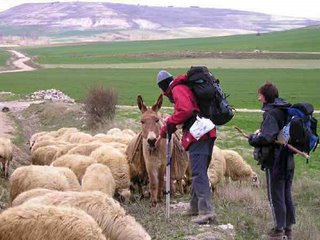
With summer bringing its promise of long dry warm days, comes the inevitable encounter with pilgrims on the roadside. And living right in the heart of Pilgrim country, the sight of single walkers or groups of people purposefully treading their way along the road of St James becomes a familiar sight.
I have always envied the Faithful their blind resolve in the face of a staring world-- be it the Believers who stop off at the airport in a side room to kneel down towards the east and Mecca -- heeding the silent call to prayer of the muezzin in the mosque tower somewhere far away, or the orthodox Jew in the plane itself draping his prayer shawl over his shoulders and standing by the door, determinedly rocking his silent prayer to his God out there, or the New Ager standing naked in the field, arms outstretched, greeting the ever reliable sun at dawn, or the Romanies trundling along the little country lanes in their colourful caravans on their way to St Maries de la Mer to go meet the two Mary's and Sarah as they come ashore after their long journey from Syria with the Christ's child (there will have to be another blog entry for that particularly fascinating story!)-- or the many many Christians who walk or ride on horseback, sometimes thousands of kilometers, on their pilgrimage to St Compostela in Spain.
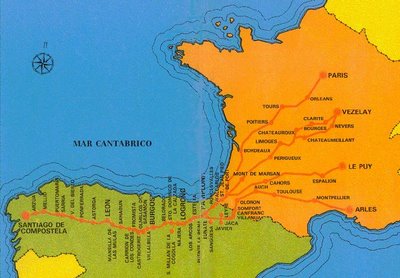
The Paris Route is the most northerly of the 4 medieval French routes described by Aimery Picaud in the Pilgrim's Guide and the one used by pilgrims from France, Northern Europe and the British Isles.
Also known as the Via Turonensis after Tours, the most important medieval city along the route.
Paris was the medieval pilgrim gathering point. Modern pilgrims variously start at Paris, go on to at Chartres (developing into an important secondary starting-point), and then to Orléans, the first major town on the route from Paris; the way follows the Loire valley to Tours, then goes south-west through Poitou and the Saintonge to Bordeaux; and finally passes through les Landes to join the routes from Le Puy and Vézelay and just beyond Saint-Palais.
The medieval route would have been along Roman roads and the main towns were all major Roman towns at important cross-roads, many already major pilgrimage centres in their own right. However, with no topographical constraints favouring a single route, there were many variants, including sea-routes to the Médoc and Bordeaux. Pilgrims carry a special 'passport' which is stamped all along the route and also used to give them access to free or very cheap accommodation in most towns and villages. That is sadly no longer the case. However, there is ample accommodation on the way, plenty of good campsites (along the rivers), some gites d'étape and chambres d'hôte - although all catering for tourists rather than pilgrims. No network of free or cheap pilgrim refuges any longer, except at Centre de Culture Européen at Saint-Jean d'Angély, at the Priory of Cayac at Gradignan (south edge of Bordeaux) and at the Franciscan convent at Saint-Palais. Persistence and good French can sometimes might produce a bargain bed.
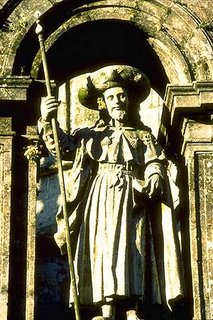 There is no single waymarked long-distance footpath covering the entire route of over a thousand kilometers. Much of the "historic" route lies under major roads and cannot be walked. Pilgrims must design their own route. The route described in the CSJ guide uses a mix of the long distance and local footpaths of the French Grandes Randonnées and Grandes Randonnées du Pays system (both waymarked) and small farm roads to replicate the traditional route as far as possible off the main roads.
There is no single waymarked long-distance footpath covering the entire route of over a thousand kilometers. Much of the "historic" route lies under major roads and cannot be walked. Pilgrims must design their own route. The route described in the CSJ guide uses a mix of the long distance and local footpaths of the French Grandes Randonnées and Grandes Randonnées du Pays system (both waymarked) and small farm roads to replicate the traditional route as far as possible off the main roads.The route is easy to walk or cycle -- the fundi's say! But then, talk to any hiker and they will tell you hiking across the Himalayas is easy! -- However, on this route, the way is generally flat, there are no significant hills or steep gradients and the paths are clearly defined. The chief features are the many wide, wooded east-west river valleys crossed by the route north of Bordeaux and the vast tracts of stabilised sand and pine forest of les Landes south of Bordeaux. The Chartres branch crosses the vast treeless plateau of the Beauce (the "bread basket" of France) and the extensive vineyards of the Loire to reach Tours. The Orléans branch follows the Loire valley with the grand chateaux of the kings and nobility of France. From Tours to Bordeaux, the way is in pleasant agricultural terrain, some deciduous forests and numerous rivers to be crossed. The vineyards begin again in the valley of the Charente and from here to Bordeaux, vines and forest mix. These provinces of Poitou and Saintonge are the lands “full of delights” according to the Pilgrim's Guide. South from Bordeaux the way passes through the unending pine forest of les Landes, an area which has enjoyed a good reputation with neither medieval or modern pilgrims - the former because of the dangers of the shifting sands and the latter because of the rather tedious landscape. If you are interested, a height profile of the route (as well as a list of the stages), you can go here.
Ever since the remains of St. James were discovered in Galicia in 813 AD, pilgrims have been traveling the route to Santiago de Compostela. Initiated in the 9th-10th centuries after the discovery of the tomb of James, a disciple of Jesus Christ, in north-west Spain, the pilgrimage to Santiago ranked third in importance, after Jerusalem and Rome, as a religious journey for western European Christians.
For many this journey is a deeply spiritual experience, but probably for most of the almost 200 000 pilgrims this year, the pilgrimage is much more about the journey itself than the destination.
Next week I am meeting a pilgrim who is coming through Lalinde -- I shall be sure to come tell you about his experiences.........
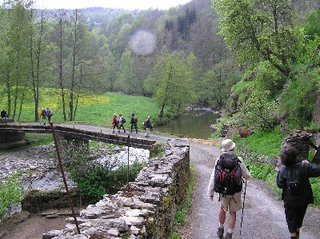
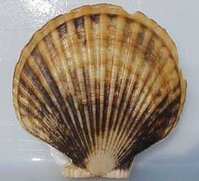
Click on Link:
Chateau Lalinde : The perfect venue for your event
TAGS: Santiago de Compostela Rent a chateau France
Special Events Chateau Lalinde Perigord Dordogne Travel Pilgrimages Activity Holidays Teambuilding Walking Hiking Golf Canoeing



